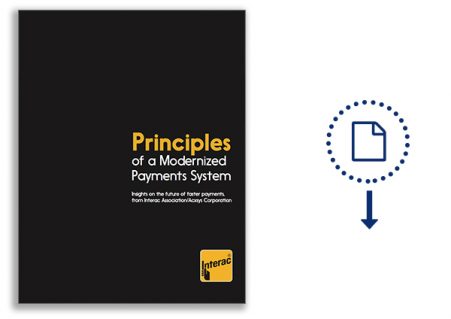The Faster Payments Reality Check

It takes more than just having the latest technology or an innovative idea to make faster payments work.
If anyone knows that, it’s Canada.
The country has been on the forefront of faster payments for years, and Peter Maoloni, AVP of online products and platforms at Interac Association/Acxsys Corporation (INTERAC), joined PYMNTS to share the digital payments pioneer’s principles of a modernized payments system.
With more than 158 million transactions processed in 2016, reflecting a value of $63.8 billion, Interac e-Transfer is Canada’s leading digital money transfer service, averaging $174.2 million per day sent.
In its latest white paper, INTERAC outlines the principles as follows:
- Principle #1: Good funds is the better model.
- Principle #2: Ubiquity should be a payment network’s natural destination.
- Principle #3: Data abstraction means privacy and security for all.
- Principle #4: Embrace standards.
- Principle #5: Closed divides, but open unifies.
While the list may seem straightforward, Maoloni noted that often these principles can be either difficult to attain or entirely overlooked as payments providers pursue the deployment of faster payments.
But it starts with having a clear understanding of what a modernized payments system truly is. Maoloni defines this as allowing for an efficient movement of money between the two people who are trying to exchange value. A modernized system enables people or businesses to have access to the money in near real time.
The Canadian Advantage
Talking about faster payments is one thing, but putting real-time payments into practice requires financial infrastructures to make the transfer of money almost frictionless and an accelerator of commercial activity — meaning it’s much easier said than done.
As Maoloni pointed out, the barriers to faster payments are often times the ability to displace current behavior.
Think the usage of paper-based payments like checks and cash.
While these may not necessarily be the greatest vehicles to exchange value, they are ubiquitous in many payment markets, which makes moving consumers and businesses away a major challenge.
“Canada has always been in the forefront of the adoption of electronic payment mechanisms, so we’re seeing the trend to displace those checks specifically or cash much more accelerated here,” Maoloni explained.
It also helps that the banking community in Canada has a long history of a coopetition model. According to Maoloni, financial institutions in the country invest in the interoperability that’s required and then compete for customer acquisition outside of that, but for the core infrastructure that’s required to move the industry forward, they tend to cooperate fairly well.
This makes sense since there is value in digitizing currencies.
For businesses, it enables the ability to do straight-through processing and limiting or shrinking down accounts receivables cycles, as well as reducing the costs associated with cash handling that are required at a merchant level. For consumers, it can be more convenient to carry a digital representation of the value in their bank account.
“I think banks in Canada have realized that at a little bit quicker and made those cooperative investments to actually accelerate the industry forward,” Maoloni said.
Prioritizing Principles
Though all five of the principles provided in INTERAC’s white paper are crucial to the development of a modernized payment system, there are some that Maoloni identified as the most important.
Two that go hand in hand are ubiquity and good funds.
With confusion in the market and an increasing number of different payment standards, ubiquity can be quite hard to achieve, but knowing that there’s a capability in market that’s uniform across financial institutions is invaluable.
“That type of ubiquity is required because it lowers the barrier to entry and allows for the interoperability to really manifest itself so that it can be a viable option for payments,” Maoloni explained.
On the other side of the same coin is the availability of good funds.
As a consumer or business, knowing that the money has left your account and the person on the other side is able to use the money in near real time makes it massively beneficial.
Maoloni noted that this is the only way to get the industry to move away from using cash or checks as that vehicle of value exchange.
Another important principle is standards, but it’s often the one that is the most difficult for payments players to get into market or adopt.
“Standards are sort of a tricky thing — they’re standards, but they tend to be implemented or deviated at the national or domestic level,” Maoloni said.
While standards are important for helping the entire payments value chain to a common point and push the market into a certain direction so that each piece of the chain doesn’t have to do a proprietary set of development or implementation, they can still be quite challenging to implement.
“We know we need to drive toward standards — the issue is that sometimes we tend to deviate them to mask certain domestic-level problems or domestic-level friction,” he said of the market as a whole.
Moving Down The Path of Openness
Another principle that is often tough for a payments industry to implement is moving away from the traditional closed approach to bringing products and services to market.
However, INTERAC’s perspective is that pursuing openness offers a more robust and innovation-encouraging way to proceed.
“We want to encourage a set of openness where people can initiate the creation of a payment instruction but not add any consumer or business risk into that type of interaction,” Maoloni explained.
He said that INTERAC will soon bring to market an integration layer via APIs for companies that don’t necessarily want to be in the business of money movement but still want to create consumer experiences that allow people to exchange money either through a request or a sending of funds. It will offer these businesses the ability to create those instructions and not take the liability or the risks in actually moving the money.
With this type of offering, third-party developers can connect to INTERAC’s application and do some portion of the payment but not take on the risk or operational overhead that comes with the storage or transmittal of funds.
“It’s the first step toward a really innovative way of dealing with the risks in payments but also allowing for non-traditional participants to actually join the network and create new or unique things that actually benefit the entire market and the consumer,” Maoloni said.
The Power Of Balance
Though INTERAC’s white paper highlights the principles needed to develop and support faster payments, Maoloni said the biggest takeaway should be the importance of balance in creating these systems.
Establishing modernized payments systems is about striking the balance between the needs of all the stakeholders and the actions needed to move the industry forward.
“The principles are the design that you need to use to architect, and the balance is really what makes that architecture scale and remain pertinent in the market that you’re trying to solve for,” Maoloni explained.
To download INTERAC’s white paper: Principles of a Modernized Payments System, click the button below:

